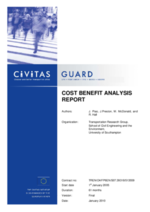Developing a city-centre car-sharing club
Summary
The car club was planned to operate from two centres: one on the university campus and one in the city centre.
Implementing sustainable mobility
The principle of a car club is straightforward in that it provides access to a pool of vehicles, available for occasional use by local people and businesses. Implementation involves scheme design, the securing of appropriately located parking spaces, the provision of suitably equipped vehicles, and ongoing promotion. The aim was for the car club to operate vehicles running on cleaner fuels.
The objectives were to reduce the amount of land used for parking private vehicles and to remove social exclusion by making private transport available to those who cannot afford to own their own vehicle.
The car club was designed to operate from two centres: one from the university campus for mature students and staff; and one in the city centre for residents and local businesses. The intention was for at least one major city-centre development to offer car club membership as part of its sales package. Users can book online or by phone and unlock the vehicle using their personal smartcard and PIN system.
Progress
The measure was launched in November 2006 with a high level of coverage in the local press. This helped to raise awareness of the system and boosted the number of enquiries and members. An article in the city council’s magazine in April resulted in further local press coverage, and the scheme was also discussed on Radio Norwich (including an on-line survey).
Outcomes
Membership of the car club has expanded steadily over the two years of operation, reaching nearly 200.
- Norwich has 10 car club vehicles in the inner suburbs and city centre.
- 74 percent of people joining the scheme in Norwich either gave up a car or chose not to buy one.
- Members of the Car Club also walk, cycle and use public transport more often.
- 79 percent of all cars replaced by the Car Club vehicles were over five years old.
- From a zero threshold in 2005/6, awareness of the club amongst the wider population of Norfolk grew to 23 percent and reached 31percent of the population in the city.
- Levels of CO2 and other pollutants decreased.









